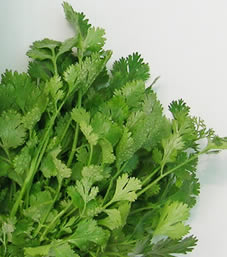Coriander
Dill
Absinthe
Basil
Borage
Calamint
Capers
Chervil
Coriander
Tarragon
Chives
Wild fennel
Lavender
Lovage
Lippia Citriodora
Marjoram
Lemon balm
Mint
Myrtle
Oregano
Chilli pepper
Salad burnet
Parsley
Rosemary
Garden rocket
Rue
Sage
Celery
Thyme
Valerian
HISTORICAL HINTS:
Coriandrum is a Latin word coming from the Greek word corys (bug), followed by the suffix -ander (alike); the two words refer to the unpleasant smell of the plant similar to bug smell, which lasts until the maturation of fruits. Coriander has been used since ancient times (5000 B.C.) by Egyptians, Jews, Greeks and Romans as aromatic and medicinal plant. Also Apicio mentioned it, because he used it as a base to prepare a seasoning called Coriandratum, while, according to Plinius, placing some seeds under the pillow at sunset could treat headache and prevent fever. Coriander is one of the oldest herbs of our tradition: during Renaissance time its fruits were iced with sugar giving start to the tradition of carnival “coriandoli” (confetti) which later on were transformed in small balls of chalk and then in small coloured paper disks.
.
THE PLANT -
Coriander (Coriandrum sativium) is an annual herbaceous plant originally from the Mediterranean Sea countries belonging to the Umbrelliferae family; it is also known as Chinese parsley because it belongs to the same family. It has thin and not very ramified roots, erected stalk, and a height of about 30-50 cm, with a ramified superior part; alternate leaves in the inferior part are barely craved and provided with a stem, while superior part leaves have ragged edge and no stem. White-pink flowers are gathered in rayed umbrellas and aromatic fruits are straw-yellow globes. Coriander fruits are used as a spice: they are sweet with a slight lemon taste and less hot than leaves, which not everybody likes because, while someone loves aroma and bitter-spicy taste, others do not appreciate it. Coriander fruit are one of the main ingredient of garam masala, a very used mix of spices of the Indian, Latin-American, and Eastern cuisine.
CULTIVATION AND HARVESTING - Coriander grows well in all southern and eastern Europe, on sunny and well exposed soils. Fruits are produced in June-July, while umbrellasharvesting, cut together with their stem, takes place in the early morning when dew is still on coriander and it must be dried soon after otherwise most of its properties get lost. Umbrellas are then gathered in bunches and hung in shade; when bunches are well dried they are beaten in a bag to separate fruits from peduncles.
PRESERVATION –
Coriander fruits are preserved in glass pots with hermetic closure and stored in cool and dry places; fruits should be preserved wholesome and grinded when used because, if preserved in powder, the aroma easily gets lost.
PROPERTIES –
Coriander has antispasmodic, carminative, antiseptic, aperitive and digestive properties. It seems to be effective in treating intestinal bloating, difficult digestion and constipation if taken in controlled amount but it is advisable not to abuse of it because it can cause nervous and kidneys disorders and it has inebriating effects if taken in big amount. In addition the spice has antibacteric and fungicide action.
CULINARY USE –
Coriander has different uses in international cuisine but not so many in the Italian tradition where it is mainly used in salami preparation as sausages and mortadella, in liqueur industry to aromatize gin for example and Chartreuse liqueur. Its sweet, intense and delicate aroma allows it to be used in big quantities without overwhelming food taste. Grinded coriander fruits represent the main ingredient for curry and garam masala. In central Europe coriander is used to season and aromatize game marinates vegetables, mushrooms and products in vinegars and in brines; while in the East leaves and small branches are used to aromatize salads instead of parsley. The ideal match of coriander is with cabbage, soups, legumes, fish, pork and lamb.























